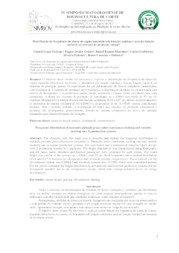Distribuição de frequência da altura do capim-marandu sob lotação contínua e taxa de lotação variável em sistemas de produção animal.
Distribuição de frequência da altura do capim-marandu sob lotação contínua e taxa de lotação variável em sistemas de produção animal.
Author(s): TSCHOPE, G. L.; GOMES, F. J.; MARCIANO, R. B.; PEDREIRA, C. G. S.; PEDREIRA, B. C. e
Summary: PT-BR: O objetivo desse estudo foi descrever e explicar a distribuição da frequência da altura do capim-marandu (Brachiaria brizantha cv. Marandu) sob lotação contínua e taxa de lotação variável em sistemas de produção animal. O experimento foi em delineamento em blocos completos casualizados, com avaliação de 2 sistemas de produção em 4 repetições. A distribuição da altura foi caracterizada com auxílio de histogramas, e os parâmetros média, moda, assimetria e curtose foram calculados para cada tratamento. A altura nos sistemas de produção foi semelhante (p = 0,888) com média de 37 cm. Os sistemas silvipastoril e pecuária tiveram distribuição acentuada (0,44 e 0,47 de curtose, respectivamente). A assimetria do sistema silvipastoril foi 0,209614 e da pecuária foi de -0,19529, valores considerados normais. Para o período avaliado, a distribuição da altura nos sistemas de produção silvipastoril e pecuária não distinguiram, possivelmente, devido ao sistema silvipastoril ter níveis de radiação adequados para desenvolvimento da forragem. | EN: The objective with this study was to describe and explain the frequency distribution of marandu palisade grass (Brachiaria brizantha cv. Marandu) under continuous stocking rate and variable stocking rate in animal production systems. The experiment was a randomized complete block design, with 2 production systems in 4 replicates. The height distribution was characterized using histograms, and the mean, mode, skewness and kurtosis parameters were calculated for each system. The sward height was similar in the systems (p = 0.888), with 37 cm. Both treatments had a marked distribution (0.44 and 0.47 of kurtosis for silvopastoral and livestock systems, respectively). The asymmetry of the silvopastoral system was 0.209614 and livestock systems was -0.1959, which were considered normal. For the period evaluated, the height distribution in silvopastoral and livestock production systems did not distinguish, possibly due to the silvopastoral system, which have enough radiation levels for forage development.
Publication year: 2017
Types of publication: Paper in annals and proceedings
Observation
Some of Embrapa's publications are published as ePub files. To read them, use or download one of the following free software options to your computer or mobile device. Android: Google Play Books; IOS: iBooks; Windows and Linux: Calibre.
Access other publications
Access the Agricultural Research Database (BDPA) to consult Embrapa's full library collection and records.
Visit Embrapa Bookstore to purchase books and other publications sold by Embrapa.

